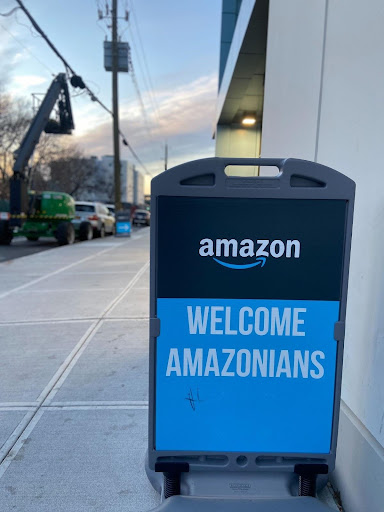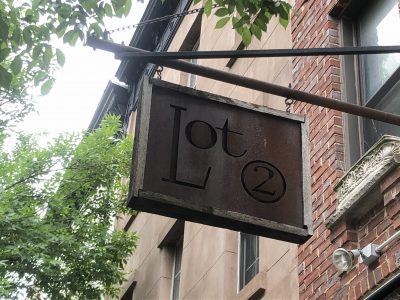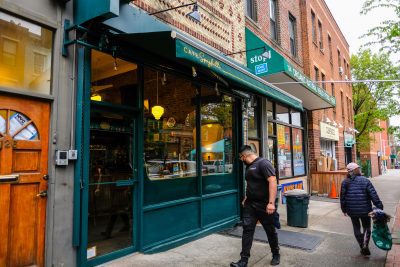Photo by Steven Pisano, licensed under CC BY 2.0.
Amazon and artificial turf: Red Hook’s big changes are frustrating residents
Between four new enormous fulfillment centers and the long-term renovation of its rec center, Red Hook is going through some things
A collection of joggers from South Brooklyn Running Club shuffle their way West on Bay Street. The group gets periodically jolted by sudden bursts of drilling on the left side of the road, a vast expanse of dirt plots that used to be natural grass fields of Red Hook’s ball fields. On the runners’ right, truck after truck make their way in and out of the newly established Amazon and UPS fulfillment centers.
For the runners, it’s an assault on the senses from two sides. For the wider community of Red Hook, it’s emblematic of a new reality.
“Things are changing fast,” says Tiffiney Davis, the co-founder of the nonprofit Red Hook Art Project. “There’s a lot happening all at once, without a way to go to the table.”
The neighborhood—a seaside enclave and dock town dating to before the Civil War that in recent decades has become a haven for artists, weirdos, foodies and, yes, gentrifiers—has been undergoing change for years. But a confluence of recent developments, notably the year-plus long renovation of The Red Hook Recreation Area and the influx of new fulfillment centers has left many local residents deeply frustrated.
‘A complete loss’
The Red Hook Recreation Area is a nearly 60-acre space that includes a swimming pool, running track, four soccer fields, five baseball fields and multiple handball courts. Hammered by Superstorm Sandy nearly a decade ago, the facility is finally undergoing a $15 million renovation, which began two years after New York congressional leaders secured federal funding for repairs—and will drag on until at least January 2023.
The temporary closure of the facility has deprived the neighborhood of a vital community center and safe haven, says Davis.
“It’s a complete loss,” she tells Brooklyn Magazine. “This is the only other larger space in the community for people to be in and can still social distance.”
Kids would use it as a safe place to go after school. Elderly members of the community would have a place to go outside of home and bond with each other. “It has a huge impact,” says Davis.
The reconstruction project aims in part to alleviate lead contamination in the facilities, which is a net positive for everyone. But one end result of the renovation is that all of the natural grass fields there will be replaced with artificial turf.
“It’s gonna look cool, it’s gonna be awesome, it’s gonna get used,” says Illya Tarasenko, a Red Hook resident, dentist, father and captain of the addled South Brooklyn Running Club. But, he adds, “there’s a loss there. Leave the infield wild!”
Tarasenko is concerned about removing “this natural barrier between fumes from automobiles” while simultaneously increasing commercial development around the park. And he’s not alone.
Basis Independent Brooklyn is counting it as a disappointment, too. The private school used the fields as an extension of its own grounds, “particularly during the pandemic,” says the school’s communications director, Jo Goldfarb.
“Our students and teachers used the green spaces closest to our school at lunch when we needed to get students outside, and our physical education team made great use of the track each week,” she says. “The remittance project has shut down a large part of the Red Hook fields for another year-and-a-half. That is a big loss to the community.”
On their website, the New York City Department of Health lists the advantages of artificial turf, including that they require little maintenance, and that they provide a consistent and resilient year-round playing surface.
“It comes down to expense,” says Roger Wilson, who has installed artificial turf fields for the city’s parks department, and who owns his own turfing company in Staten Island. “I mean, you spend a million dollars on a field and get 10 to 15 years out of it before they have to replace it.”
In some ways, though, the upending of the multi-acreage recreation area is exacerbated by another recent development in the neighborhood that will likely have a longer-term impact on the entire neighborhood.

Photo by Kellen Bulger
The last straw of ‘last mile’
As online shopping becomes the norm and supply chain issues make headlines, companies are putting more and more warehouses—so-called “last mile” facilities—into neighborhoods all over the city in order to more quickly ship items locally. Red Hook alone has one UPS and three Amazon fulfillment centers, all steps from the shuttered recreation center. Environmental advocates and community groups have grown increasingly vocal about their dissatisfaction with what some have termed “environmental racism” as truck traffic spikes to fulfill delivery orders and residents lack recourse to weigh in.
“This is predominantly an area where there’s so many children coming from so many areas and there’s too many trucks,” says Davis. “It’s insane. In the streets, it’s just too much. All these trucks in the streets; the kids don’t have a place to be off the streets because the rec center is closed.”
Much of the waterfront area in Red Hook is zoned specifically for manufacturing purposes. And manufacturing warehouses need city permits and environmental impact studies to be acquired to set up shop in the neighborhood. Fulfillment centers, where goods are not technically manufactured, are in no need of such permits.
In May of 2019, after acquiring the historic Lidgerwood Building at 202 Coffey Street, UPS demolished the structure, despite pleas from neighbors to save it. UPS only took over the site after Italian developer Est4te Four scrapped plans to build a $400 million, 1.2 million square-foot development there in 2017. The “Red Hook Innovation District” was never able to get off the ground due to a lack of investor confidence in the untried (and flood-prone) waterfront.
“If you don’t support adaptive reuse to bring the building or sites alive for jobs, public space, housing, et cetera, the only thing left is storage or distribution,” says one developer familiar with the deal, who declined to be identified.
To put it another way: If you don’t build it, they won’t come.
“[Amazon and UPS] didn’t have to go through any community review, no rezoning required,” says Jenny Zhang, the chief of staff for Assemblymember Marcela Mitaynes, who represents Brooklyn’s 51st district, encompassing Red Hook.
“It’s also a little bit unfortunate that Red Hook, given all of the kind of climate and flooding that it’s gone through, is not prioritizing this land for resiliency work or environmental justice work, but that this is becoming the use,” she adds.
For his part, Peter Fleming, who serves as chair of Community Board 6, just wants everyone to get along.
“The community board usually tries to act as a facilitator. Our goal is to bring sides together and to get them to concede,” he says. “[The community board] looks to help Amazon and other businesses learn to behave in a way that’s comfortable for the neighborhood.”
Asked for a comment on the fulfilment centers, a representative from Amazon tells Brooklyn Magazine in a statement that, “Amazon strives to be a great neighbor. We are always working with local community leaders and follow all city permits and guidelines to ensure our Amazon sites do not disrupt the community, such as staggering breaks to avoid rush hour and working directly with our delivery partners, community partners, neighbors and other stakeholders to help manage traffic.”
Be that as it may, Red Hook, famously devoid of subway stops and largely cut off from the rest of the borough, was always a hard place to get to. More and more, though, people are finding it harder to get around in.
You might also like 


























